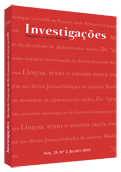De “Grandes” a Pequenas Estórias: contribuições de uma nova perspectiva para a análise da narrativa
Abstract
Este trabalho discute dois modelos teóricos para a análise da narrativa, a partir da identificação deste tipo textual enquanto a) artefato elaborado por um ou mais falantes, recapitulando experiências pessoais, composto de seções específicas e; b) construto temporalmente organizado, cuja extensão e formato não são fixos. No primeiro caso, o foco são as narrativas completas do modelo Laboviano. No segundo, incluem-se as “pequenas estórias” (Georgakopoulou 2007), foco da mais recente linha analítica. Exemplificamos a análise de narrativas orais, coletadas em português, que emergiram no contexto de conversas-entrevista, nas quais os falantes descreviam experiências de racismo.References
BAMBERG, Michael G. W. 1997. Positioning Between Structure and Performance. Language and Society 25: 167-203.
CHAFE, Wallace. 1990. Discourse, Consciousness and Time. Chicago: University of Chicago.
CHARON, Rita. 1986. To Render the Lives of Patients. Literature and Medicine 5:58-74.
CLARK, Herbert & RICHARD, Gerrig. 1990. Quotations as Demonstrations. Language 66:764-805.
DE FINA, Anna. 2003. Identity in Narrative: A Study of Immigrant Discourse. Amsterdam/Philadelphia: John Benjamins.
______. 2000. Orientation in immigrant narratives: The role of ethnicity in the identification of characters. Discourse Studies 2(2):131-157.
FAIRCLOUGH, Norman. 1992. Discourse and social change. Cambridge: Polity Press.
FLANNERY, Mércia S. 2008. She discriminated against her own race: voicing and identity in a story of discrimination. Narrative Inquiry 18(1):111-130.
GEORGAKOPOULOU, Alexandra. 2007. Small Stories. Interactions and Identities. Amsterdam/Philadelphia: Johns Benjamins.
GOFFMAN, Ervin. 1981. Forms of Talk. Philadelphia: University of Pennsylvania Press.
GOODWIN, Charles. 1986. Audience Diversity, Participation and Interpretation. Text 6:283-316.
HARRÉ, Rom; LANGENHOVE, van Luk. (eds.) 1999. Positioning Theory. Oxford:Blackwell Publishers.
LABOV, William. 2001. Uncovering The Event Structure of Narrative. Georgetown University Round Table on Languages and Linguistics, Washington, DC: Georgetown University Press, pp. 63-83.
LABOV, William & WALETSKY, Joshua 1967. Narrative Analysis: Oral Versions of Personal Experience, In: Helm, J. (Ed.). Essays on the Verbal and Visual Arts. Seattle/ London: University of Washington Press, pp. 12-44.
MISHLER, Elliot G. 1986. Research Interview: context and narrative. Cambridge, Massachusetts: Harvard University Press.
OCHS, Elinor and CAPPS, Lisa. 2001. Living Narrative: Creating lives in everyday storytelling. Cambridge, Mass.: Harvard University Press.
POLANYI, Livia. 1985. Telling the American story. Norwood: Ablex.
SCHIFFRIN, Deborah. 2006. In other words: variation in reference and narrative. Cambridge: Cambridge University Press.
______.1996. Narrative as Self-Portrait: Sociolinguistic. Constructions of Identity Language in Society 25(2):167-201.
______. 1982. Tense Variation in Narrative. Language 57: 45-62.
TANNEN, Deborah. 1989. Talking Voices: Repetition, Dialogue and Imagery in Conversational Discourse. Cambridge University Press.
VAN LEEUWEN, Teun.1996. The representation of social actors. In: Rosa Caldas, Carmen; Coulthard, Malcolm. Readings in critical discourse analysis. New York: Routledge.
Downloads
Published
How to Cite
Issue
Section
License
Copyright (c) 2010 Mércia Regina Santana Flannery

This work is licensed under a Creative Commons Attribution 4.0 International License.
Authors who publish with Revista Investigações agree to the following terms:
Authors retain copyright and grant the journal right of first publication with the work simultaneously licensed under the Creative Commons Attribution 4.0 International (CC BY 4.0) license that allows others to share the work with an acknowledgement of the work's authorship and initial publication in this journal.
Authors are able to enter into separate, additional contractual arrangements for the non-exclusive distribution of the journal's published version of the work (e.g., post it to an institutional repository or publish it in a book), with an acknowledgement of its initial publication in this journal.
You are free to:
Share — copy and redistribute the material in any medium or format for any purpose, even commercially.
Adapt — remix, transform, and build upon the material for any purpose, even commercially.
The licensor cannot revoke these freedoms as long as you follow the license terms.
Under the following terms:
Attribution — You must give appropriate credit , provide a link to the license, and indicate if changes were made . You may do so in any reasonable manner, but not in any way that suggests the licensor endorses you or your use.
No additional restrictions — You may not apply legal terms or technological measures that legally restrict others from doing anything the license permits.

